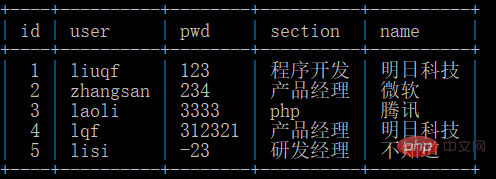 Database
Database
 Mysql Tutorial
Mysql Tutorial
 Analysis on the difference between super key, primary key and candidate key in MySQL
Analysis on the difference between super key, primary key and candidate key in MySQL
Analysis on the difference between super key, primary key and candidate key in MySQL
This article brings you relevant knowledge about mysql. It mainly introduces the differences between super keys, primary keys and candidate keys in MySQL. It has a good reference value. I hope it will be helpful to everyone. Helps.

Recommended learning: mysql video tutorial
About the difference between super key, primary key and candidate key
Recently, I encountered a question when reading a MySQL book:
Since we already have the concept of primary key, and the primary key can already meet the needs, why do we still need such a thing as a candidate key? What is the role of candidate keys? It's given a candidate key definition but it doesn't really mess around with anything.
With the mentality of asking for more information, I searched online and looked at the explanations of the masters. I was still a little confused, so I wanted to sort it out here to help myself understand more clearly. , I also hope that if there is any misunderstanding, someone can give me some pointers Here are some of my understandings:
In fact, primary keys and super keys are better. For example, there is such a table:

#The writing in the table is a bit rough, so I’ll just take a look at it.
Super key
The set of attributes that can uniquely identify a tuple in a relationship is called the super key of the relational schema. Note the "attribute set" in the definition. The super key can be a large set, as long as it can determine which row it is, so 'id', 'user', 'pwd', 'section', 'name' are all OK is the set of superkeys.
Candidate key
Super key that does not contain redundant attributes. For example, in the above super key, 'id' can determine which row it is by itself, so it can be a candidate key by itself. , the other four besides it can also be candidate keys, but these five are put together because there are redundant columns, they are not candidate keys. (The other four can be candidate keys because each column may have duplicate content)
Primary key
Find one of all candidate keys for use as the primary key, that is to say It can be an id, or a combination of the other four, or other choices, as long as it can ensure that the selected set can be uniquely determined.
In summary, candidate keys are a subset of super keys, and primary keys are a subset of candidate keys.
In fact, after sorting out so much, I still don’t understand what the function of the candidate key is. In fact, it may be like a waiting hall. There is only one seat left in the car, and there are several primary keys in the waiting hall. Sit down and tell you: "We have all bought tickets and are eligible to get on the bus. Whoever you choose to get on the bus will get on the bus with you." That should be it.
Understand the concepts and relationships of super keys, candidate keys, primary keys
Basic concepts
- Super key: A key that uniquely identifies a tuple in a relationship The set of attributes is called the superkey/key of the relational schema.
- Candidate key: A superkey that does not contain redundant attributes is called a candidate key, that is, its true subset is no longer a superkey.
- Primary key: A candidate key selected by the user as a tuple identifier is called the primary key and is one of the candidate keys.
Relationship
The candidate key is a subset of the superkey, and the primary key is one of the candidate keys.
As an example
Consider the attribute set (ID number, name, gender, age), assuming there are no duplicate names
a. The super keys are:
- ID number, name, (name, gender), (name, gender, age), etc.
- --It can be seen here that the super key can uniquely Determine a person’s attribute group
b. The candidate key in the super key
- is unique in ID number and name, and has no redundant attributes. So it is a candidate key
- --It can be seen here that the candidate key is a super key without redundant attributes
c. Select the primary key
- Users can choose their name or ID number as the primary key according to their own preferences
- --The primary key is a selected candidate key
Still don’t understand?
Example:
In the SQL Server database, there is a student information table as shown below. The set of attributes that cannot be used as candidate keys in this table is ( ) ( Select one)
Student ID Name Gender Age Department Major
20020612 Li Huinan 20 Computer Software Development
20060613 Zhang Mingnan 18 Computer Software Development
20060614 Wang Xiaoyu Female 19 Physical Mechanics
20060615 Li Shuhua female 17 Biological Zoology
20060616 Zhao Jingnan 21 Chemistry Food Chemistry
20060617 Zhao Jing female 20 Biological Botany
a) {Student ID}
b) {Student number, name}
c) {Age, department}
d) {Name, gender}
e) {Name, major}
Recommended learning: mysql video tutorial
The above is the detailed content of Analysis on the difference between super key, primary key and candidate key in MySQL. For more information, please follow other related articles on the PHP Chinese website!

Hot AI Tools

Undresser.AI Undress
AI-powered app for creating realistic nude photos

AI Clothes Remover
Online AI tool for removing clothes from photos.

Undress AI Tool
Undress images for free

Clothoff.io
AI clothes remover

Video Face Swap
Swap faces in any video effortlessly with our completely free AI face swap tool!

Hot Article

Hot Tools

Notepad++7.3.1
Easy-to-use and free code editor

SublimeText3 Chinese version
Chinese version, very easy to use

Zend Studio 13.0.1
Powerful PHP integrated development environment

Dreamweaver CS6
Visual web development tools

SublimeText3 Mac version
God-level code editing software (SublimeText3)

Hot Topics
 1663
1663
 14
14
 1419
1419
 52
52
 1313
1313
 25
25
 1263
1263
 29
29
 1237
1237
 24
24
 MySQL's Role: Databases in Web Applications
Apr 17, 2025 am 12:23 AM
MySQL's Role: Databases in Web Applications
Apr 17, 2025 am 12:23 AM
The main role of MySQL in web applications is to store and manage data. 1.MySQL efficiently processes user information, product catalogs, transaction records and other data. 2. Through SQL query, developers can extract information from the database to generate dynamic content. 3.MySQL works based on the client-server model to ensure acceptable query speed.
 Laravel Introduction Example
Apr 18, 2025 pm 12:45 PM
Laravel Introduction Example
Apr 18, 2025 pm 12:45 PM
Laravel is a PHP framework for easy building of web applications. It provides a range of powerful features including: Installation: Install the Laravel CLI globally with Composer and create applications in the project directory. Routing: Define the relationship between the URL and the handler in routes/web.php. View: Create a view in resources/views to render the application's interface. Database Integration: Provides out-of-the-box integration with databases such as MySQL and uses migration to create and modify tables. Model and Controller: The model represents the database entity and the controller processes HTTP requests.
 MySQL and phpMyAdmin: Core Features and Functions
Apr 22, 2025 am 12:12 AM
MySQL and phpMyAdmin: Core Features and Functions
Apr 22, 2025 am 12:12 AM
MySQL and phpMyAdmin are powerful database management tools. 1) MySQL is used to create databases and tables, and to execute DML and SQL queries. 2) phpMyAdmin provides an intuitive interface for database management, table structure management, data operations and user permission management.
 Solve database connection problem: a practical case of using minii/db library
Apr 18, 2025 am 07:09 AM
Solve database connection problem: a practical case of using minii/db library
Apr 18, 2025 am 07:09 AM
I encountered a tricky problem when developing a small application: the need to quickly integrate a lightweight database operation library. After trying multiple libraries, I found that they either have too much functionality or are not very compatible. Eventually, I found minii/db, a simplified version based on Yii2 that solved my problem perfectly.
 MySQL vs. Other Programming Languages: A Comparison
Apr 19, 2025 am 12:22 AM
MySQL vs. Other Programming Languages: A Comparison
Apr 19, 2025 am 12:22 AM
Compared with other programming languages, MySQL is mainly used to store and manage data, while other languages such as Python, Java, and C are used for logical processing and application development. MySQL is known for its high performance, scalability and cross-platform support, suitable for data management needs, while other languages have advantages in their respective fields such as data analytics, enterprise applications, and system programming.
 Laravel framework installation method
Apr 18, 2025 pm 12:54 PM
Laravel framework installation method
Apr 18, 2025 pm 12:54 PM
Article summary: This article provides detailed step-by-step instructions to guide readers on how to easily install the Laravel framework. Laravel is a powerful PHP framework that speeds up the development process of web applications. This tutorial covers the installation process from system requirements to configuring databases and setting up routing. By following these steps, readers can quickly and efficiently lay a solid foundation for their Laravel project.
 MySQL for Beginners: Getting Started with Database Management
Apr 18, 2025 am 12:10 AM
MySQL for Beginners: Getting Started with Database Management
Apr 18, 2025 am 12:10 AM
The basic operations of MySQL include creating databases, tables, and using SQL to perform CRUD operations on data. 1. Create a database: CREATEDATABASEmy_first_db; 2. Create a table: CREATETABLEbooks(idINTAUTO_INCREMENTPRIMARYKEY, titleVARCHAR(100)NOTNULL, authorVARCHAR(100)NOTNULL, published_yearINT); 3. Insert data: INSERTINTObooks(title, author, published_year)VA
 Solve MySQL mode problem: The experience of using the TheliaMySQLModesChecker module
Apr 18, 2025 am 08:42 AM
Solve MySQL mode problem: The experience of using the TheliaMySQLModesChecker module
Apr 18, 2025 am 08:42 AM
When developing an e-commerce website using Thelia, I encountered a tricky problem: MySQL mode is not set properly, causing some features to not function properly. After some exploration, I found a module called TheliaMySQLModesChecker, which is able to automatically fix the MySQL pattern required by Thelia, completely solving my troubles.



